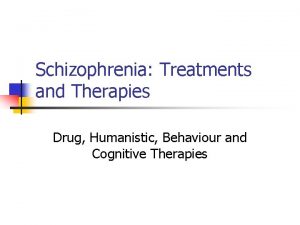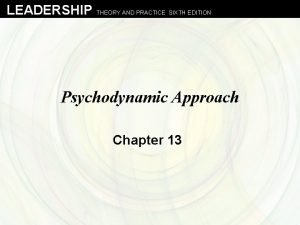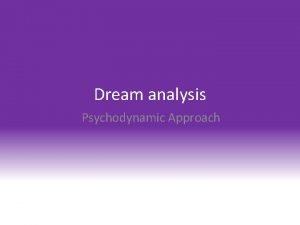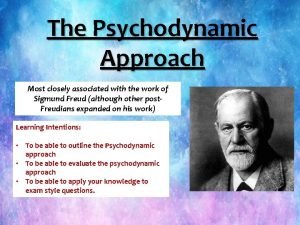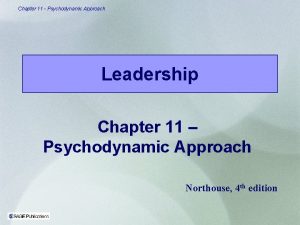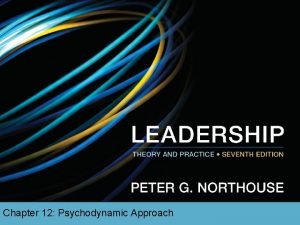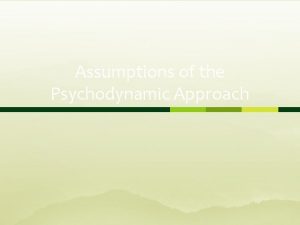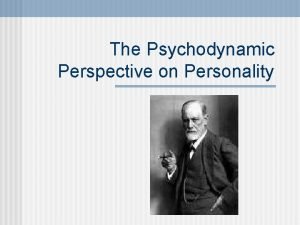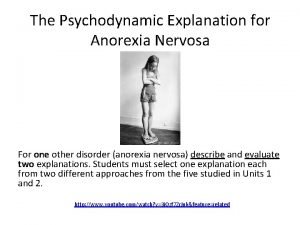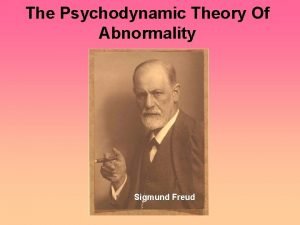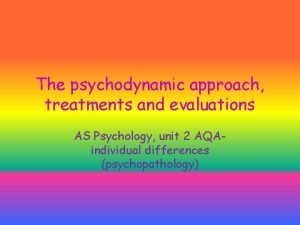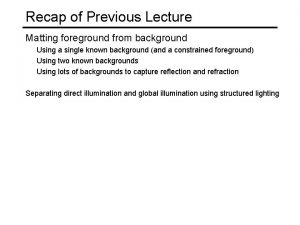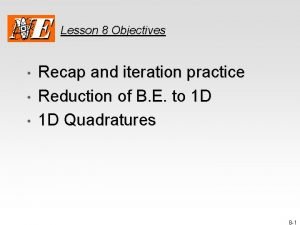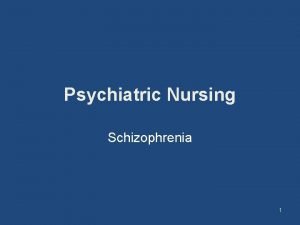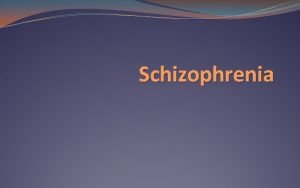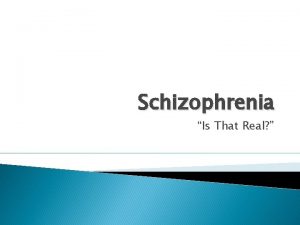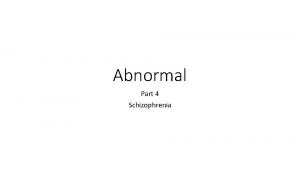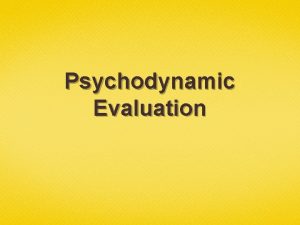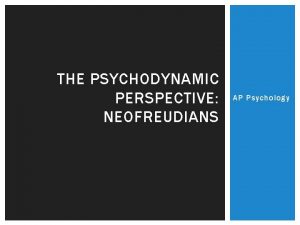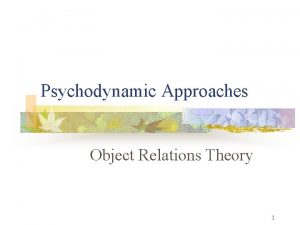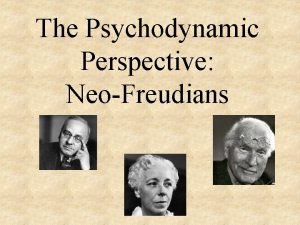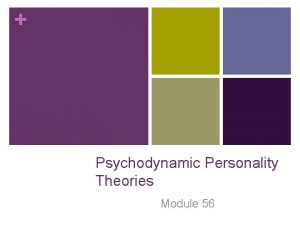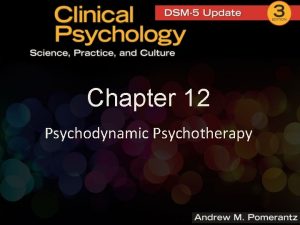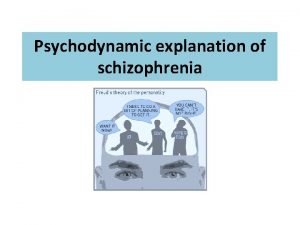Psychodynamic Approach Schizophrenia RECAP Psychodynamic approach What is























- Slides: 23

Psychodynamic Approach Schizophrenia

RECAP – Psychodynamic approach What is the main assumption of this approach? How is the personality explained in the psychodynamic approach? What are defence mechanisms? Examples

Different explanations Using the hand-outs, each of you focus on one – either: Regression/defence mechanisms, Schizophrenogenic mother/Double bind hypothesis or Expressed Emotion Provide a summary of your explanation

Regression

Schizophrenogenic Mother

Expressed Emotion (EE)

REGRESSION Schizophrenia (SZ) may reflect regression and a poorly developed ego – issues in childhood The ego may be overwhelmed by the demands from the Id or by feelings of guilt from the superego & so the individual regresses to the safety and security of the oral stage. In the 1 st stage the ego has not yet properly developed & the child can’t distinguish between itself & its fantasies & the external world.

CHILDHOOD EVENTS According to the psychodynamic approach, family relationships dramatically influence the way a growing child perceives reality. If trauma carries on into adulthood, then schizophrenia could result. There are several family problems which are thought to contribute to the formation of schizophrenia: Schizophrenogenic Mother Double-bind Hypothesis Expressed Emotion

Schizophrenogenic Mother A schizophrenogenic has actions that are often contradictory – verbally accepting yet behaviourally rejecting. This can set up faulty communication between both mother and child and can lead to the onset of schizophrenia.

Double-Bind Hypothesis ‘Double-bind’ communication is witnessed in the schizophrenogenic mother. Double-bind communication is contradictory communication. For example, a mother will ask for a hug and then pull away – the child is placed in a ‘no win’ scenario. The child cannot avoid displeasing the parent, thus can become confused and suspicious – this can contribute to the onset of schizophrenia.

Study: Schofield and Balian (1959) This study used 178 schizophrenic patients and 150 non-sufferers, non-sufferers comparing their childhood experiences to see whether schizophrenics really did have more difficult childhood relationships. It was found that with the quality of relationships between the parents there was no difference found between the two samples. However there were significant differences in the reported quality of mothering with patients' mothers being less likely to be affectionate and more likely to be domineering and overprotective.

Conclusion The results are thus consistent with theory of the schizophrenogenic mother – the only childhood circumstances that appeared to increase the risk of schizophrenia in adulthood were related to the quality of the maternal relationship. Though the study was able to produce qualitative data, it was restricted to America, thus it is hard to generalise the findings to the wider public without being ethnocentric.

Expressed Emotion (EE) refers to hostility, criticalness and concern in the family environment after someone has been diagnosed. It therefore examines the development of schizophrenia as opposed to the onset. Brown et al (1966) examined progression of schizophrenia when patients were discharged from hospital and lived with their families. Families were either high EE or low EE. 58% of patients who returned to high EE families relapsed, compared to only 10% of those who returned to low EE families.

Projective Identification EE is linked to the psychodynamic concept of PI. This is when the person without Sz projects emotions onto the person with Sz. So, in some families, the pressure caused by the diagnosis of Sz on the people around the patient can lead them to act in a way that perpetuates the Sz. What will this cause?

Diathesis Stress and Schizophrenia The confusion from these contradictory messages could lead to self doubt and withdrawal – but is this enough to lead to schizophrenia? How could the Diathesis Stress model explain Schizophrenia using this family life theory? What study have you already got that supports this theory? That no cause is readily apparent for Sz gives ammunition to those who doubt the validity of the diagnosis. Sz seems to need a specific set of circumstances before it begins to change behaviour. A fractured family background alone is not a sufficient

Evaluation Reductionist? Deterministic? Is it fair to blame parenting? Is it scientific/objective? BUT Research support Different perspective into the human mind unconscious

Psychodynamic theory is not adequate to explain Sz because its approach to childhood developmental problems is too simplistic. Sz appears to be a multifaceted disorder with many factors contributing to its onset. You can take something from most of the major perspectives and apply it to Sz but one approach alone is not sufficient.

Weaknesses of the Psychodynamic Approach One weakness of the psychodynamic approach is that it’s deterministic. This suggests that all thoughts, behaviours and emotions are determined by our childhood experiences and unconscious mental processes. This is a weakness because it suggests we have no conscious free will over our behaviour. Another weakness of the psychodynamic approach is that it is reductionist. This reduces the main reason for our thoughts, emotions and behaviour down to childhood experiences and unconscious mental processes. This is a weakness because it does not take into account the influence of our biology and genetics.

Continued. . . But the data is retrospective – the memory may not always be accurate. They are memories of people with SZ so may be distorted as a consequence of their illness. There’s not much data for support of F-R’s views. Research suggests that most people with SZ don’t come from this type of family. Also some people with SZ will suffer a relapse even if they’ve been moved from their families entirely. Leads to parents being blamed for their children’s problems – In the early part of the 20 century the wide spread belief of this theory led to many parents th feeling guilty because of the implication of it being their fault. It’s now recognised as unjust since its excepted that biological problems probably influence the disorder. People with SZ don’t really behave like children – they don’t behave as a child would as children don’t normally have hallucinations. The theory is unscientific (behaviourists would argue) – it refers to structures like the Id, Ego and unconscious which are not observable, empirical evidence.

Strengths of the Psychodynamic Approach One strength of the psychodynamic approach is that it acknowledges the impact of the early childhood experiences on the adult personality and behaviour. This is a strength because it provides a level of insight that other approaches lack and also gives adults a reason for their irrational behaviour that can lead them to realise that the behaviour is not their fault.

Strengths of the Psychodynamic Approach Another strength of the psychodynamic approach is the focus on the role of the unconscious mind in determining thoughts, behaviour and emotions. Using the role of unconscious mental processes can explain why we think and behave irrationally. We are driven by unconscious conflicts that we have no conscious answer of. This is a strength because it provides a different perspective into the human mind.

Task If high rates of EE within families is a contributory factor in developing Sz, what should treatments be targeting?

HW – Due Weds 24/09 Plan and write an essay for the following question: Discuss one psychological explanation of schizophrenia (12 marks) Need to outline as well as evaluate the explanation – use research!
 Strengths of the psychodynamic approach
Strengths of the psychodynamic approach Humanistic approach to schizophrenia
Humanistic approach to schizophrenia Psychodynamic approach to leadership
Psychodynamic approach to leadership Weaknesses of the psychodynamic approach
Weaknesses of the psychodynamic approach The psychodynamic perspective
The psychodynamic perspective Psychodynamic approach to leadership
Psychodynamic approach to leadership Psychodynamic approach to leadership
Psychodynamic approach to leadership Assumption of psychodynamic theory
Assumption of psychodynamic theory Psychodynamic approach to personality
Psychodynamic approach to personality Psychodynamic theory of personality
Psychodynamic theory of personality Freud anorexia
Freud anorexia Psychosexual fixation
Psychosexual fixation Psychodynamic approach evaluation
Psychodynamic approach evaluation Segmented pricing
Segmented pricing Briefly recap
Briefly recap Recap background
Recap background Chapter 8 and 9 summary great gatsby
Chapter 8 and 9 summary great gatsby Ldeq recap
Ldeq recap Logbook recap example
Logbook recap example Recap database
Recap database Let's recap
Let's recap Lets have a recap
Lets have a recap Recap from last week
Recap from last week What is the purpose of an iteration recap?
What is the purpose of an iteration recap?

